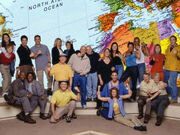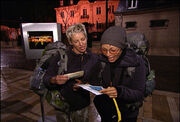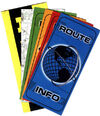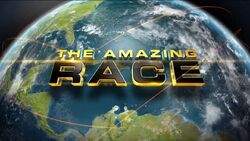- For other uses of 'The Amazing Race', see The Amazing Race (disambiguation).
The Amazing Race is a reality television game show in which teams of two race around the world in competition with other teams. Contestants strive to arrive first at the end of each leg of the race to avoid the possibility of elimination. Teams are progressively eliminated until three teams are left; at that point, the team who arrives first in the final leg is awarded a large cash grand prize. Created by Elise Doganieri and Bertram van Munster, the original series has aired in the United States since 2001 and has earned ten Primetime Emmy Awards, including seven consecutive "Outstanding Reality-Competition Program" awards.
Contestants travel to and within multiple countries in a variety of transportation modes including planes, taxis, rental cars, trains, and boats. The clues in each leg point the teams to the next destination or direct them to perform a task, either together or by a single member. Each task showcases the geographic region or local culture and customs it is held in. If a team is in last place at the end of a leg of the Race, they may be forced to stop competing or have a significant disadvantage in the following leg.
The basic premise of The Amazing Race can perhaps best be summarized by Phil Keoghan's narration during the opening credits of The Amazing Race 1:
- “It’s the most daring competition ever attempted, 11 two-person teams bound by friendship, love, or family, will race around the world. They have no idea where they’re going, what dangers they may encounter, or how the journey will affect their lives. Most of the teams will be eliminated, but the team that reaches the Finish Line first, will win a cash prize of one million dollars. This is a race like no other in history. This is... The Amazing Race.”
Though seasonal twists, rule changes, and adaptations by international versions have occasionally experimented with tinkering the format of the Race, this premise has otherwise remained consistent throughout the show's run.
The Race[]
Contestants[]

The Amazing Race 1 contestants.
- For a list of all contestants, see Category:Teams.
In every season, all teams are composed of two people (except four members of families in The Amazing Race: Family Edition) with a preexisting relationship with common relationships include married, dating, siblings, co-workers, parent-child, and friends. Teams with returning seasons include Seasons 11, 18, and 24. Season 31 featured some returning teams competing against teams from sister shows Survivor and Big Brother. In Season 26, half of the teams were strangers who were on "blind dates". In Season 29, every team was composed of two strangers who had only met at the Starting Line.
Legs[]
Each leg of the race is comprised of teams departing the Pit Stop and traveling to a new destination or locale (indicated by a yellow and red Route Marker). Once there, the teams will perform tasks, typically at least one Roadblock and one Detour per leg, and receive sealed envelopes containing clues to their next destination upon completion of each task.
Money[]

Carol & Brandy count their money at the beginning of Leg 7 on Season 16.
- Main article: Money
At the beginning of most legs, teams receive an equal amount of cash to purchase transportation, food, and other necessary items along the Race. This money is usually given in US dollars regardless of the current location of the Race. Teams are not required to return their money at the end of each leg, thus they may opt to save a portion of their money for later in the Race. Occasionally, teams will receive no money at the start of a leg, making budgeting their accumulated money important. All teams also carry a credit card used to purchase economy airline tickets. This card may not be used in any other situation.
If a team spends all of their money or has it taken away in a Non-Elimination Leg, they may try to get more money in any way that does not violate local laws. This includes borrowing money from other teams, begging from locals, or selling their possessions.
Clues[]

- Main article: Clues
Throughout the Race, clues indicate tasks that teams must complete, directions where teams must go, or other pertinent information that guide teams along the Race. Most clues provide clear, direct instructions, though some may be written cryptic language that teams must decipher. Clue may be retrieved out of Clue Boxes or given to teams upon completion of each task.
Pit Stops[]

Mark & Michael are eliminated at a Pit Stop in China in Season 14.
- Main article: Pit Stop
Pit Stops are the final destination in each leg of the race. Each Pit Stop is a mandatory rest period which allows teams to eat, sleep, and mingle with each other. Production provides food and accommodations free-of-charge at each Pit Stop so that teams are not required to spend their accumulated money. Originally, teams were required to stay at each Pit Stop for 12 hours, though later seasons changed this to variable lengths in order to accommodate production's schedule.
Teams have been greeted at every Pit Stop the host and a local of that country (a "greeter" typically dressed in the local costume), except in Season 1, when a local greeted them and host Phil Keoghan was only present to greet the last place team and inform them if they had been eliminated or saved by a non-elimination leg.
Elimination[]
- Main article: Elimination
- Main article: Non-Elimination Leg
The last team to arrive at the Pit Stop is eliminated, barring any penalties, or unless that leg of the Race is one of the predetermined Non-Elimination Legs. In most legs, the first team to arrive wins a prize such as a vacation or cruise, which they receive after that particular season has aired on television. The eliminations themselves have now earned the name "Philimination" in the Amazing Race fan community, a portmanteau of the name of the original US version's host, Phil Keoghan, and the word "elimination".
Season 34 was the first season to remove any non-elimination legs, with every leg concluding with a normal elimination at the Pit Stop.
Superlegs and Megalegs[]
Season 6 introduced the first double-length "superleg", two single-length legs combined into one, shown over two episodes. The televised episode ended with a 'To Be Continued' message instead of a Pit Stop. The second half of the leg featured a second Detour and second Roadblock. Several seasons have each featured a superleg with teams meeting the host on the usual Pit Stop mat at the midpoint, only to have him hand them the next clue instead of checking them in. Most superlegs have an informal rest period incorporated into its design at some point (such as an hours of operation or a long plane or train ride), mimicking the effects of a Pit Stop, albeit still requiring teams to spend their own money.
Season 32 introduced a variant of the superleg called a "megaleg", which unlike a superleg, lacks a proper midpoint and does not have a rest period incorporated into its design.
No-Rest Legs[]

Chuck & Wynona are informed that the next leg would begin immediately at a Pit Stop in New Zealand on Season 22.
- Main article: No-Rest Leg
Season 18 introduced the concept of a no-rest leg. These function identically to that of a normal leg, except that the host informs teams that they are starting the next leg of the Race immediately. Typically, these legs are non-elimination, and the last team to arrive is not penalized with the version's typical penalty. However, some no-rest legs have occasionally featured an elimination for the last team to arrive at the Pit Stop. These have replaced superlegs in the American version, but have been used alongside superlegs in some international versions.
Surprise Elimination Legs[]
- Main article: Surprise Elimination

Bilal & Sa'eed at the Meridian Gate in China on Season 10 learning that they are eliminated.
Season 10 introduced the first surprise elimination point, when the last team to arrive at a checkpoint midway through the first leg was eliminated on the spot. At the end of the leg, there was a normal elimination at the Pit Stop. Surprise eliminations may occur with the last team to finish a Starting Line Task being eliminated on the spot or simply being the last team to arrive at a predetermined checkpoint. Teams are generally informed beforehand if there is a surprise elimination at any point other than a Pit Stop.
Double Elimination[]
Season 19 introduced the double elimination, where the last two teams to check at the Pit Stop were eliminated. Like with surprise eliminations, teams are informed beforehand if there is a double elimination at the end of a leg.
Final Leg[]
- Main article: Finish Line

Nat & Kat cross the Finish Line at Greystone Mansion on Season 17.
Three teams compete in the final leg of the Race. Originally, the first part of the leg included intermediate destination(s) where the teams must travel to complete a series of tasks (Alaska in US seasons 1, 2, and 9; Hawaii in US seasons 3, 4, 6, and 11; Canada in US seasons 5 and 8; Puerto Rico in US season 7; France in US season 10). The second part of the leg has teams traveling to a final destination, usually located in a major city. Remaining teams must complete one or more tasks before receiving the clue directing them to the Finish Line.
Later seasons have dropped intermediate destinations for the final leg in favor of holding all tasks in the final destination city. At the Finish Line, the host and all the eliminated teams wait for the final three teams to arrive.
The first team to reach the Finish Line wins the race and the top cash prize, which varies depending on the version of the show. All other teams win lesser amounts of money on a sliding scale based on their finishing order[1]
Ideally, all three remaining teams arrive at the Finish Line within a reasonable amount of time. On occasion, the third place team has fallen so far behind the other two teams that they cannot finish the Race in a timely manner. In this case, after the other two teams finish, they are informed that the Race is over at their next Route Marker (Joe & Bill in Season 1; David & Jeff in Season 4).
Rules and Penalties[]
- Main article: Rules and Penalties
All teams must abide by the rules set at the beginning of the Race. Failure to do so may result in time penalties, which can negatively affect their finishing position in the leg in which the infraction occurred. While the complete set of official rules has not been released to the public, certain rules have been revealed during the various editions of the Race. See Rules and Penalties for a complete list.
Production[]
- For an overview of the production of the American series, see The Amazing Race (US)#Production
The production of The Amazing Race is a challenge due to its premise being a race around the world. Among the difficult duties that producers face, scoping out locations, designing tasks, selecting teams, and planning logistics for the entire course are the most important to accomplish in pre-production. During the Race, the camera and sound crews need to keep up with the movement of the teams and the host. Upon conclusion of filming, team members and crew are responsible for not leaking any spoilers that may hint at locations, events, or outcomes of the Race until it airs. Notably, Season 33 had the longest break in filming, with a 19-month suspension due to the onset of the COVID-19 pandemic in early 2020 and did not resume until late 2021.
Through its efforts, the American version has received many accolades, including Primetime Emmy Awards and nominations in categories for audio and video production and editing.
- For an overview of Emmy nominations and awards and other accolades of the American series, see The Amazing Race (US)#Awards.
External Links[]
- Official websites
References[]
| The Amazing Race Season Index | |
|---|---|
| United States | 1 · 2 · 3 · 4 · 5 · 6 · 7 · 8 · 9 · 10 · 11 · 12 · 13 · 14 · 15 · 16 · 17 · 18 · 19 · 20 · 21 · 22 · 23 · 24 · 25 · 26 · 27 · 28 · 29 · 30 · 31 · 32 · 33 · 34 · 35 · 36 |
| Asia | 1 · 2 · 3 · 4 · 5 |
| Australia | 1 · 2 · 3 · 4 · 5 · 6 · 7 |
| Brazil | 1 |
| Canada | 1 · 2 · 3 · 4 · 5 · 6 · 7 · 8 · 9 · 10 |
| Central Europe | Cancelled |
| China | 1 · 2 · 3 · 4 |
| China Rush | 1 · 2 · 3 |
| Finland | 1 · 2 |
| France | 1 |
| Israel | 1 · 2 · 3 · 4 · 5 · 6 · 7 · 8 |
| Latin America | 1 · 2 · 3 · 4 · 5 · 6 |
| Norway | 1 · 2 |
| Philippines | 1 · 2 |
| Ukraine | 1 |
| Vietnam | 1 · 2 · 3 · 4 · 5 · 6 |

